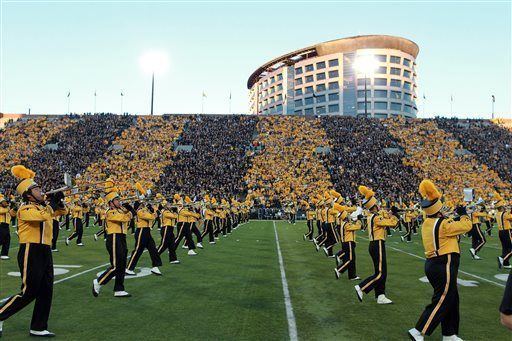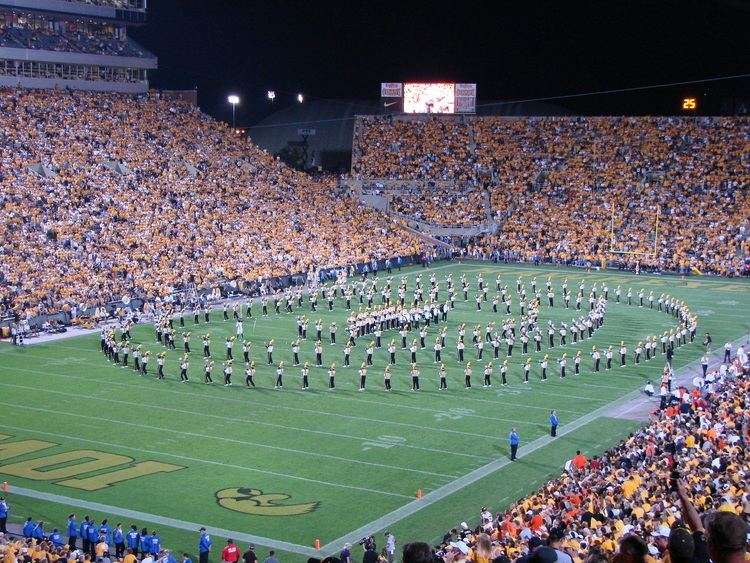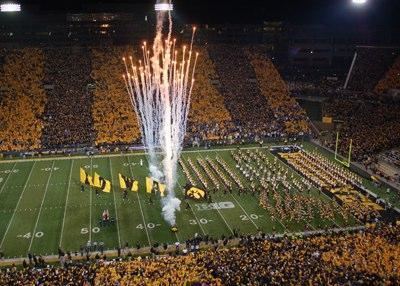Director Kevin Kastens | Founded 1881 (1881) Members 250+ Conference Big Ten Conference | |
 | ||
Uniform Gold coat with gold center and black/white trim. "IOWA" printed across the chest. Black pants with gold stripe, white spats, and black shoes. Black and gold shako with "I" logo and gold plume. Similar Indiana University Marching, Iowa State University Cyclone, University of Nebraska, University of Minnesot, Marching Illini | ||
Hawkeye marching band extravaganza 1
The Hawkeye Marching Band (or HMB) is the marching band for the University of Iowa. 250 members strong, it performs at all home Hawkeye football games inside historic Kinnick Stadium. It is the largest and most visible musical ensemble at the university and was awarded the Louis Sudler Intercollegiate Marching Band Trophy in 1990. The band was founded in 1881 as a military band, giving membership to both music students and members of the military
Contents
- Hawkeye marching band extravaganza 1
- The hawkeye marching band performs at the hawkeye huddle
- History
- Instrumentation
- Drum Major
- Golden Girl
- Section Leaders and Undergraduate Staff
- Marching Style
- Performances
- Past Directors
- Traditions
- References

The hawkeye marching band performs at the hawkeye huddle
History

The Hawkeye Marching Band was founded in 1881 in order to provide music for the State University of Iowa Battalion. During this time, members of the band would undergo the same training as their military counterparts. However, over the years, the military and band would gradually grow into separate entities. Because of this growing rift between the two organizations, the marching band became more of a form of entertainment than a military group by the year 1929, the same year that Kinnick Stadium was completed. The band became a part of the Fine Arts department in 1936.

Around this time, when the distinction between the military and the marching band grew larger, the band began to perform for more public events, rather than the military gatherings of the past. The Iowa marching band, like other Big Ten bands, began to make appearances at concerts, University ceremonies, and football games. During the mid-twentieth century, the band adopted a very militaristic style of marching. Marchers were expected to march with crack precision and the band's director during that time, Frederick C. Ebbs, eliminated any flags or twirlers that the band had used up to that point.

In 1973, Morgan Jones became director of the Hawkeye Marching Band and once again changed the style and look of the band. Jones added a line of flag twirlers and six other twirlers to accompany the featured twirler. Jones also changed the style of music played. The band began to perform different styles of music, easygoing slow music and loud fast-paced music, as well as displaying both abstract formations and recognizable patterns on the field. The Hawkeye Marching Band was widely regarded as one of the few bands that effectively executed all of these things. After the 1990 season, the band was awarded the prestigious John Philip Sousa Foundation Sudler Trophy. The 1990 season and the Sudler Trophy would mark the end of the Morgan Jones era for the HMB. Jones' 18 year period as director was one of the most successful in the history of the Hawkeye Marching Band.

The band went through three different directors during the next few years and included a brief return by Morgan Jones during the mid-1990s. In the summer of 1998, the band found its next permanent director in Kevin Kastens, current HMB director and former director of the Marching Mizzou from the University of Missouri, as well as the Marching Hundred, from Indiana University.
Instrumentation
There are ten sections in the HMB: piccolos, clarinets, alto saxophones, tenor saxophones, trumpets, mellophones, trombones, baritones, sousaphones, and a drumline consisting of snare drums, tenor drums, bass drums, and cymbals.
Instrumental sections are led by a section leader, who is charged with teaching the required musical selections for a particular show; and an "undergrad staff" member, who is in charge of teaching marching fundamentals to the section during the band's training week known as "Hell Week".
The HMB uses a squad system when writing drills for both pregame and halftime. Squads are composed of four members of a particular section and are designated an alphabetical symbol in marching drills. Sometimes, squads can be composed of members of different sections. For example, one particular squad may be made up of two members of the trumpet section and two members of the trombone section.
Sometimes, members of a section are placed on "reserve" for a certain week. This is because the amount of spots in a particular drill may not have enough spots for every member of a section. HMB members who are placed on reserve fill vacant spots during rehearsals and may even be called upon to fill spots during performances if the original member is not able to attend. Members placed on reserve may also be called upon to aid the graduate staff members with equipment or other items during performances.
Drum Major
The drum major position is the highest rank that an undergraduate student can attain in the Hawkeye Marching Band. The drum major performs routines during both pregame and halftime shows and incorporates a mace during these routines. Students achieving the rank of drum major are also required to instruct the band during much of the training period at the beginning of a marching season. The current drum major is Isaac Anderson.
A notable Hawkeye drum major and University of Iowa alumnus is David Woodley, from Winterset, Iowa. Woodley is currently director of the Marching Hundred of Indiana University.
Golden Girl
Like many other collegiate marching bands, a featured baton twirler is used. In the HMB, this twirler is known as the "Golden Girl". The University of Iowa Golden Girl is one of only two full tuition scholarships available to the feature twirlers in the nation. Like the drum major, the Golden Girl performs choreographed routines during both pregame and halftime. Many of these routines are choreographed for both the drum major and Golden Girl performing with each other. The current Golden Girl is Whittney Seckar-Anderson.
Former Golden Girls Linda Simon, Jayna Sanchez and Diana Reed represented Iowa, and Laurie Broderick represented Indiana, in the Miss America pageant; Jane Stemmerman represented Iowa in Distinguished Young Women. All utilized their baton skills in the talent competition. Former Golden Girl Nikki Meredith (now Crawford) was World Champion twirler in 1984 and won the 2011 Ms Fitness USA.
Section Leaders and Undergraduate Staff
Section leaders are undergraduate members of the HMB and are responsible for the musical performance of their respective sections. Section leaders conduct musical warm-ups at all rehearsals and before performances and instruct their sections on new musical selections.
Undergraduate staff members instruct HMB members in their section, both first-year and veteran members, on marching fundamentals and techniques. Both section leaders and undergraduate staffers may be called upon to serve as squad leaders after the conclusion of Hell Week.
Marching Style
The HMB employs a traditional Big Ten chair step marching style, where the upper leg is lifted parallel to the ground forming a 120 degree angle with the lower leg, and the foot is pointed to the ground. The band uses this traditional style during their pregame performance, parades, and lengthy drum cadence called "The Series". During the band's halftime performance, a more contemporary low-step style (glide step) is used, where the toe is pointed upwards and the heel is rolled along the ground.
Performances
The Hawkeye Marching Band performs at all Iowa Hawkeye home football games. The band also travels with the team to usually one away game per year and the team's post-season bowl game when the team plays in one. The band also travels to Ames, Iowa every other year when the Hawkeyes play the Iowa State Cyclones in the annual battle for the Cy-Hawk Trophy.
The band also holds an indoor concert at Carver Hawkeye Arena (this concert was previously held in Hancher Auditorium but was moved due to the damage of Hancher Auditorium by the Flood of 2008) on the University of Iowa campus towards the end of the marching season. Along with other University musical groups, the HMB performs the traditional school songs like On Iowa, The Iowa Fight Song, and "Roll Along Iowa", and the different halftime selections from throughout the year.
Every third year, the band travels to Cedar Rapids, Iowa where seven local metropolitan Cedar Rapids high school bands, along with the HMB, hold an exhibition of their halftime shows at the Cedar Rapids Indoor Marching Classic. The Hawkeye Marching Band rotates every third year with the Iowa State University Cyclone Football 'Varsity' Marching Band and the University of Northern Iowa Panther Marching Band (debut performance for 2007 was October 22, 2007).
Past Directors
note In 1967, Frank Piersol was named Director of Bands succeeding Fred Ebbs who left for Indiana University. Tom Davis, assistant professor of music and percussion instructor, actually took over as the HMB director.
